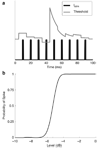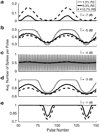Encoding and decoding amplitude-modulated cochlear implant stimuli--a point process analysis
- PMID: 20177761
- PMCID: PMC2898280
- DOI: 10.1007/s10827-010-0224-9
Encoding and decoding amplitude-modulated cochlear implant stimuli--a point process analysis
Abstract
Cochlear implant speech processors stimulate the auditory nerve by delivering amplitude-modulated electrical pulse trains to intracochlear electrodes. Studying how auditory nerve cells encode modulation information is of fundamental importance, therefore, to understanding cochlear implant function and improving speech perception in cochlear implant users. In this paper, we analyze simulated responses of the auditory nerve to amplitude-modulated cochlear implant stimuli using a point process model. First, we quantify the information encoded in the spike trains by testing an ideal observer's ability to detect amplitude modulation in a two-alternative forced-choice task. We vary the amount of information available to the observer to probe how spike timing and averaged firing rate encode modulation. Second, we construct a neural decoding method that predicts several qualitative trends observed in psychophysical tests of amplitude modulation detection in cochlear implant listeners. We find that modulation information is primarily available in the sequence of spike times. The performance of an ideal observer, however, is inconsistent with observed trends in psychophysical data. Using a neural decoding method that jitters spike times to degrade its temporal resolution and then computes a common measure of phase locking from spike trains of a heterogeneous population of model nerve cells, we predict the correct qualitative dependence of modulation detection thresholds on modulation frequency and stimulus level. The decoder does not predict the observed loss of modulation sensitivity at high carrier pulse rates, but this framework can be applied to future models that better represent auditory nerve responses to high carrier pulse rate stimuli. The supplemental material of this article contains the article's data in an active, re-usable format.
Figures















Similar articles
-
Relationship Between Peripheral and Psychophysical Measures of Amplitude Modulation Detection in Cochlear Implant Users.Ear Hear. 2017 Sep/Oct;38(5):e268-e284. doi: 10.1097/AUD.0000000000000417. Ear Hear. 2017. PMID: 28207576 Free PMC article.
-
Auditory cortex phase locking to amplitude-modulated cochlear implant pulse trains.J Neurophysiol. 2008 Jul;100(1):76-91. doi: 10.1152/jn.01109.2007. Epub 2008 Mar 26. J Neurophysiol. 2008. PMID: 18367697 Free PMC article.
-
Recording and analysis of electrically evoked compound action potentials (ECAPs) with MED-EL cochlear implants and different artifact reduction strategies in Matlab.J Neurosci Methods. 2010 Aug 15;191(1):66-74. doi: 10.1016/j.jneumeth.2010.06.008. Epub 2010 Jun 15. J Neurosci Methods. 2010. PMID: 20558202
-
Modeled auditory nerve responses to amplitude modulated cochlear implant stimulation.Hear Res. 2017 Aug;351:19-33. doi: 10.1016/j.heares.2017.05.007. Epub 2017 May 19. Hear Res. 2017. PMID: 28625417
-
Examining the auditory nerve fiber response to high rate cochlear implant stimulation: chronic sensorineural hearing loss and facilitation.J Neurophysiol. 2010 Dec;104(6):3124-35. doi: 10.1152/jn.00500.2010. Epub 2010 Oct 6. J Neurophysiol. 2010. PMID: 20926607 Free PMC article.
Cited by
-
Ability of primary auditory cortical neurons to detect amplitude modulation with rate and temporal codes: neurometric analysis.J Neurophysiol. 2012 Jun;107(12):3325-41. doi: 10.1152/jn.00812.2011. Epub 2012 Mar 14. J Neurophysiol. 2012. PMID: 22422997 Free PMC article.
-
Simulated auditory nerve axon demyelination alters sensitivity and response timing to extracellular stimulation.Hear Res. 2018 Apr;361:121-137. doi: 10.1016/j.heares.2018.01.014. Epub 2018 Feb 14. Hear Res. 2018. PMID: 29496363 Free PMC article.
-
Neural coding and perception of auditory motion direction based on interaural time differences.J Neurophysiol. 2019 Oct 1;122(4):1821-1842. doi: 10.1152/jn.00081.2019. Epub 2019 Aug 28. J Neurophysiol. 2019. PMID: 31461376 Free PMC article.
-
Resolving molecular contributions of ion channel noise to interspike interval variability through stochastic shielding.Biol Cybern. 2021 Jun;115(3):267-302. doi: 10.1007/s00422-021-00877-7. Epub 2021 May 22. Biol Cybern. 2021. PMID: 34021802
-
Development and validation of a spectro-temporal processing test for cochlear-implant listeners.J Acoust Soc Am. 2018 Nov;144(5):2983. doi: 10.1121/1.5079636. J Acoust Soc Am. 2018. PMID: 30522311 Free PMC article.
References
-
- Briaire J, Frijns J. Field patterns in a 3d tapered spiral model of the electrically stimulated cochlea. Hearing Research. 2000;148:18–30. - PubMed
-
- Bruce IC, Irlicht LS, White MW, O’Leary SJ, Dynes S, Javel E, et al. A stochastic model of the electrically stimulated auditory nerve: Pulse-train response. IEEE Transactions on Biomedical Engineering. 1999a;46(6):630–637. - PubMed
-
- Bruce IC, White MW, Irlicht L, O’Leary SJ, Clark GM. The effects of stochastic neural activity in a model predicting intensity perception with cochlear implants: Low-rate stimulation. IEEE Transactions on Biomedical Engineering. 1999b;46(12):1393–1404. - PubMed
-
- Bruce IC, White MW, Irlicht LS, O’Leary SJ, Dynes S, Javel E, et al. A stochastic model of the electrically stimulated auditory nerve: Single-pulse response. IEEE Transactions on Biomedical Engineering. 1999c;46(6):617–629. - PubMed
-
- Bruce IC, Irlicht LS, White MW, O’Leary SJ, Clark GM. Renewal-process approximation of a stochastic threshold model for electrical neural stimulation. Journal of Comparative Neurology. 2000;9(2):119–132. - PubMed
Publication types
MeSH terms
Grants and funding
LinkOut - more resources
Full Text Sources
Medical

